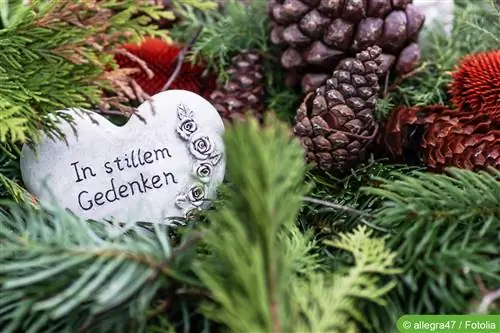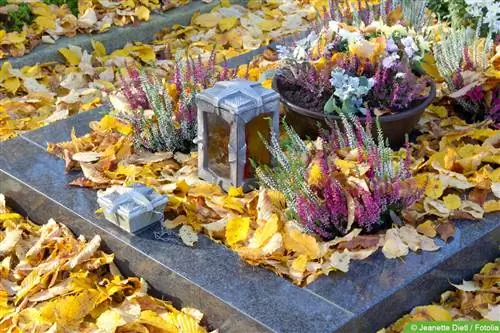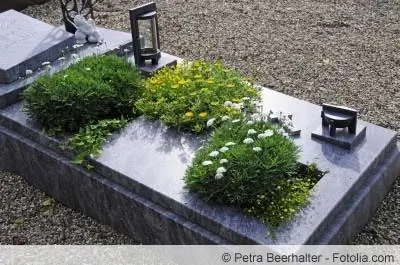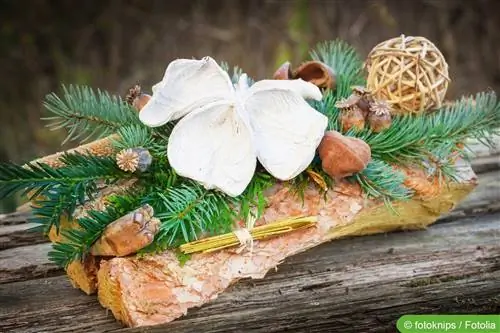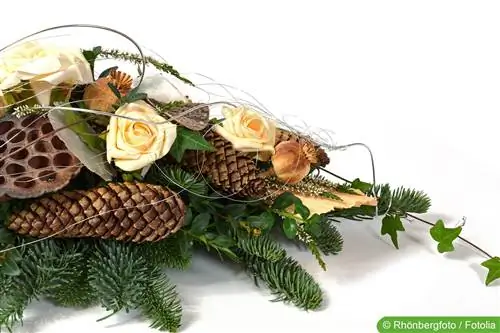- Author admin [email protected].
- Public 2024-01-31 11:14.
- Last modified 2025-06-01 06:48.
A special grave decoration for All Saints' Day, All Souls' Day and Sunday of the Dead? Well, these holidays, which do not come during the most beautiful time of year, are church holidays that are intended to encourage us to remember our dead. During November, the time has come to decorate the grave with a winter-proof decoration that will look decorative long after the last All Souls' Day lights have burned out or the arrangements from Dead Sunday have dried up.
The right grave decorations for All Saints Day and All Souls Day
All Saints Day and All Souls Day are the days of the year that are particularly dedicated to the memory of the deceased. All Saints' Day, the day of remembrance for all saints, came about because the number of saints had increased so dramatically in the first Christian centuries that the celebration of all personal days of honor was approaching a year-round festival. That's why these commemorations were combined into one day: November 1st. was chosen to commemorate all those who have been canonized, but also the ordinary deceased whose sanctity only God knows. November 2nd, All Souls' Day, was added at the end of the 10th century at the initiative of the Benedictine Abbey of Cluny to commemorate the deceased who, according to Catholic teaching, had not yet been able to achieve full communion with God.
Grave decorations on All Souls' Day definitely include candles, sometimes very special ones, such as. B. the Mainz Newweling. When these candles are lit varies from region to region and also has to do with when the graves are blessed. Actually, All Souls' Day is the day dedicated to the poor souls in purgatory and on which the graves are blessed and decorated with lights. In many places, the blessing of the graves takes place on All Saints' Day, and the light decoration is also carried out on this day and illuminates the grave on the eve of All Souls' Day. This certainly has something to do with the fact that All Saints' Day is a feast day of the Roman Catholic and Protestant churches, while All Souls' Day is actually only celebrated by Catholics. In any case, on one of these two days the deceased can enjoy your memory and a sea of lights on the grave. You can see how beautiful that can look at https://commons.wikimedia.org/wiki/File:Wszystkich_swietych_cmentarz.jpg" />
The grave decorations on All Saints' Day and All Souls' Day are traditionally rather simple and inconspicuous and revolve primarily around the theme of light. Some design ideas around this topic:
- A grave covered with ground cover plants doesn't need more than many different lights as decoration, simple grave lights or special All Souls candles.
- Additional decoration for sparsely overgrown graves can be achieved with fir branches, which are laid out on the grade and the lights are decorated above them.
- To ensure that such a decoration is not blown off the grave at the first gust of wind, you should attach the pine branches to the ground with ivy needles and clamp the lights between them securely.
- As long as you don't leave the aesthetically restrained frame set up for this celebration, you can vary the decoration: with other green branches, with silver-colored lantern holders, with bows in soft colors, for example.
- The age of LED lighting also brings us new possibilities with regard to lighting at the grave: you could, for example. For example, you can make the entire grave light up with self-made lanterns, inside which small, battery-operated LED lights are attached.
- If this idea seems a little strange in its modernity, remember that the All Souls Lights are intended to be “Eternal Lights,” and a well-protected LED light could meet these requirements for much longer than any candle
If your home region is home to one of the many folk customs for All Souls Day, it is a nice idea to include such a custom when you visit the cemetery with the whole family. The more senses are stimulated by a special event, the longer it will stay in your memory. If after the Mass and after the graves have been decorated with the “Eternal Lights” Haddekuche or soul pretzels, soul braids or soul cakes are served, the day will become an important memory, especially for children.
The grave decoration on Sunday of the Dead
The Sunday of the Dead is the day on which the deceased are remembered in the Protestant church. It is also called Eternal Sunday and is set on the last Sunday before the first Advent. This makes it the last Sunday in the church year, which begins with the first Sunday of Advent. Because the fourth Sunday of Advent must always be before December 25th, the Sunday of the Dead inevitably falls on a date between the 20th.and November 26th.
An abundance of light decorations on graves is not so well known in the Protestant Church; on this last Sunday of the church year, the graves are traditionally decorated with arrangements or flowers. Florist shops offer suitable arrangements in the run-up to the Sunday of the Dead. You can of course also make your own grave decorations. You will find many suggestions for this in the article “Design your own grave decorations”.
Plants for grave decorations
What begonias, fuchsias and marigolds were for summer, chrysanthemums with their many warm, muted colors are for autumn. If it doesn't get too frosty, they bloom especially in more sheltered places until the first bitter cold - sometimes even into December. It is now almost impossible to imagine autumn grave decorations without the autumn heather (Erica gracilis) with its white, pink or reddish flowering varieties. The wetter and foggy the weather is, the better your chances are of holding out until frost, because your root ball should never dry out completely. In this regard, common heather is less problematic because it requires significantly less water. Pansies are also traditionally planted. They bloom until November, go dormant in winter and awaken again in spring. All plants can be planted separately or mixed directly in the soil or in bowls. Heather plants and flowers can be combined very well with interspersed branches and shoot tips of juniper, cypress, yew, mountain pine, thuja or fir. This not only underlines the mood of these days - but also protects both the plants and the soil from frost.
If you plant plenty of spring-flowering bulbs such as snowdrops, tulips or daffodils between the plants in autumn, you will be rewarded with a small, blooming spring idyll in the cemetery a few months later.
Old customs are maintained by those who use traditional cemetery plants, almost all of which have symbolic character. Small trees such as boxwood, dwarf juniper, dwarf pines, dwarf yews or ground cover are suitable as fixed, resistant, winter-hardy, evergreen plants: sedum, the small evergreen, ivy. The cemetery classic ivy, like the boxwood, the yew and the evergreen, stands for permanence, immortality, eternal Life. And for loy alty - even after death. But flowers also have symbolic power. They stretch towards the sun and open their calyx as a symbol of the liberation of the soul after death.
Wintergreen branches provide warm greenery. A typical grave decoration for the days of remembrance in November is the simple, natural forest wreath, which, with its coniferous branches, cones, moss, tree sponges, thistles, leaves or even small wooden discs, fits perfectly into the autumnal, almost wintery atmosphere of these days. Blue fir is ideal for winter arrangements or wreaths as it brings subdued vibrancy to graves. The usual arrangements consist of conifer green or Iceland moss, decorated with bows and cones, corkscrew hazel, thistles, ivy and vines. With a little skill, you can easily make conventional symbols such as crosses, wreaths or hearts yourself using blanks made of plug-in compound and winding wire. The raw material for this is provided by the autumn forest or the pruning that is due anyway in the garden: juniper, cypress, boxwood, thuja, etc. mixed with ivy or moss, cones, berries, possibly harmoniously combined with fresh cut flowers or dried flowers.
Winding ivy branches with rose petals in them look particularly simple, delicate and lovely.
Already in the Middle Ages it was customary to decorate graves with candles (Jesus Christ - the light of the world). Today this is a widespread, loving ritual. The gesture of lighting a candle for the deceased is an expression of public mourning and is intended to say to our loved ones: üI was with you ü I have not forgotten you.ü It is touching to see how the cemetery turns into a warm sea of lights at dusk - because they all live on in our hearts.

